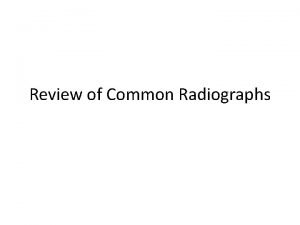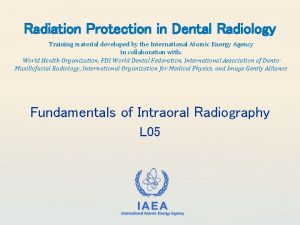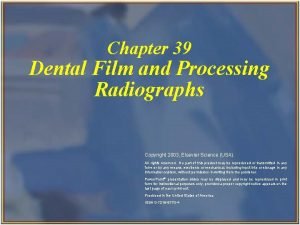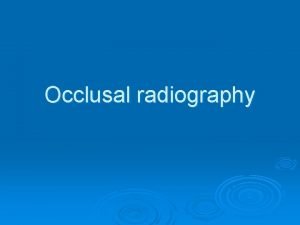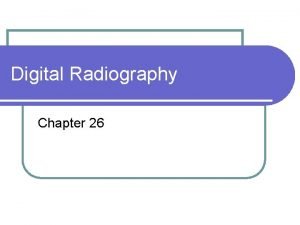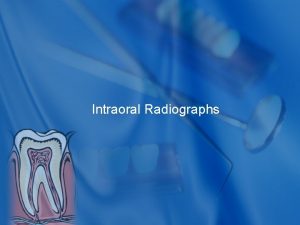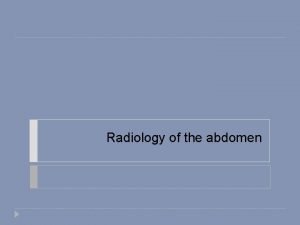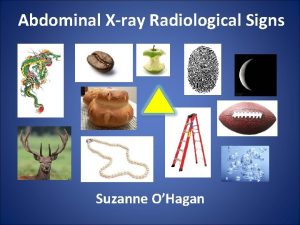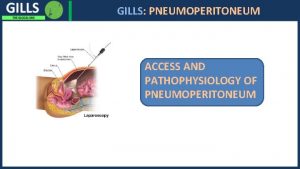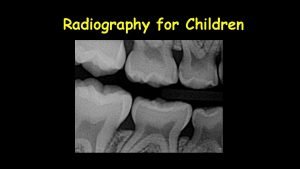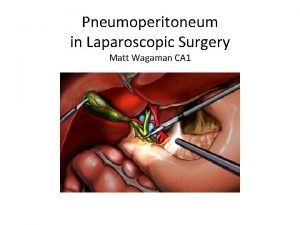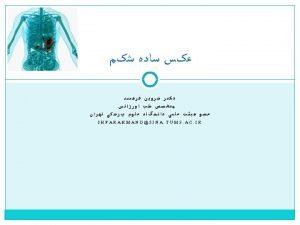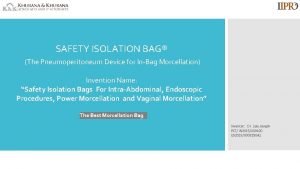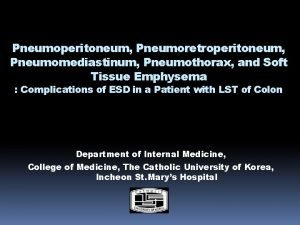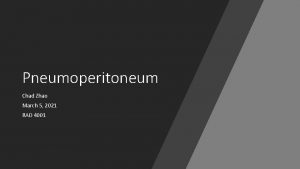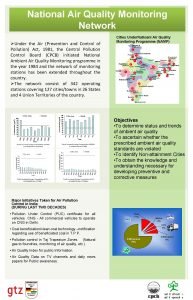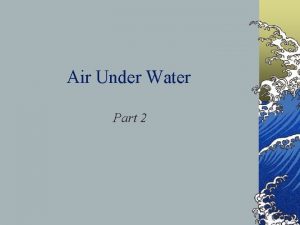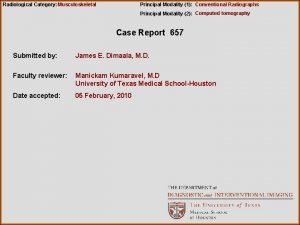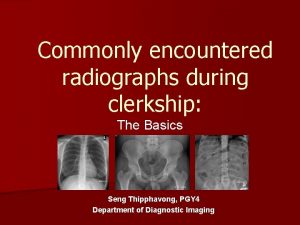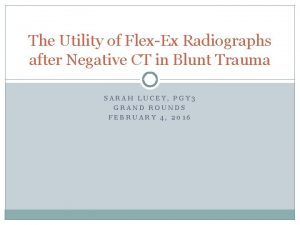Review of Common Radiographs Pneumoperitoneum Air under the
























































- Slides: 56

Review of Common Radiographs





Pneumoperitoneum/ Air under the diaphragm • Erect Chest Xray • Pneumoperitoneum indicates a perforated viscous • Causes : perforated PUD(duodenal ulcer), ruptured appendicitis, typhoid perforation, necrotising enterocolitis, ruptured inflammatory bowel disease, ruptured diverticulitis, bowel cancer, penetrating trauma.


Pleural Effusion • • • Obliteration of the costophrenic angle Obliteration of the cardiophrenic angle Tracheal deviation Meniscus sign Compensatory hyperinflation Causes : heart failure, nephrotic syndrome, cirrhosis, pneumonia, tuberculosis, mesothelioma, bronchogenic CA, SLE, trauma.



Congestive Cardiac Failure • • • Alveolar oedema Kelly B lines Cardiomegally Upper lobe deviation Pleural Effusion


Cannonball Metastases of the Lungs • • • Causes; Renal cell carcinoma Endometrial carcinoma Choriocarcinoma Prostate cancer



Foreign Body in the Oesophagus • Common sites are the cervical constriction, broncho-aortic constriction and diaphragmatic constriction. • Common foreign object: coin, dentures, bone • Treatment: antibiotics, endoscopic removal, thoracotomy


Widened mediastinium • Diagnostic feature—widened mediastinum (>8 cm at level of aortic knob) • Causes : aortic aneurysm, traumatic aortic rupture, aortic unfolding, mediastinal lymphadenopathy, pericardial effusion



Lobar Pneumonia and Bronchopneumonia • Lobar pneumonia is usually unilateral and involves a lobe • Bronchopneumonia is usually bilateral with patchy reticulonodular opacities.


Lung Cavitation Nodular mass with a central air-filled area Causes: Bronchogenic Ca Pulmonary tuberculosis Lung abscess Pulmonary metastases from breast and GIT tumours • Pulmonary coccidioidomycosis • • •




Intestinal Obstruction Supine Xray : Dilated/distended bowel loops Erect Xray : Multiple air-fluid levels Classifications: Based on Site: Small bowel or Large bowel Based on aetiopathology: Mechanical or Funtional • Based on onset : congenital or acquired • • •

Intestinal Obstruction • Congenital: anorectal malformation, intestinal atresia, congenital megacolon, congenital bands and adhesions. • Mechanical Obstruction: hernia, adhesion, volvulus, tuberculous stricture, malignancies, worm infestation, fecal impaction. • Functional Obstruction: electrolyte imbalance, spinal injuries, bowel surgeries.



Chronic Osteomyelitis • • • Involucrum Sequestrum Cortical destruction Periosteal elevation Cloaca Pathological fracture

Chronic Osteomyelitis • Common causes : Staphylococcus aureus, Escherichia coli, Pseudomonas spp, Klebsiella spp, Salmonella spp. • Treatment : antibiotics(clindamycin, flouroquinolones, augmentin), sequestrectomy, saucerization, decortication.



Gallstones • Hyperechoic area casting a posterior acoustic shadow. • Risk factors : obesity, drugs, ileal diseases, ileal resection, parasitic infection(ascariasis) • Cholesterol, Pigment and Mixed gall stones • Cholecystectomy


Kidney Stones • Mostly radiopaque • Calcium, cystine , uric acid and struvite stones • Aetiology : hyperparathyroidism hyperoxaluria, high citrate level, vitamin A deficiency, pyelonephritis, prolonged immobilisation,

Kidney Stones • • Increased fluid intake Medical : Nifedipine, tamsulosin Minimal Invasive surgery : ESWL, PNL Open Surgeries: Open Nephrolithotomy

Barium Studies • Barium swallow: used to outline the pharynx and oesophagus. • Barium meal: used to outline the stomach and the first part of the small intestine • Barium follow through: used to outline the small intestine • Barium enema: used to outline the colon



Achalasia • Absent or reduced ganglions within the myenteric plexus • Mostly idiopathic • Can be caused by vitamin B 1 deficiency, Chagas disease and can be congenital • Dysphagia, weight loss, regurgitation • Heller’s procedure




Duodenal Atresia • Commonest intestinal atresia • 1 in 10, 000 live births • Can occur in isolation or with other conditions like – Downs syndrome, – anorectal malformations, – CHD, – annular pancrease

Duodenal atresia • Vomiting, dehydration, jaundice, growth retardation • Fluids, electrolyte correction, nutrition(TPN) • Surgery: Duodenoduodenostomy, duodenostomy.


Acute Subdural haematoma • • • Crescentic hyperdense lesion Effacement of the lateral ventricle Midline shift Damage to bridging veins T



Chronic Subdural haematoma • • Hypodense lesion There might not be midline shift If asymptomatic, serial CT monitoring If symptomatic, burr hole craniostomy



Extradural Haematoma • • • Biconvex(lens shaped) hyperdense lesion Effacement of ipsilateral ventricle Midline shift Lucid interval is a common feature Emergency craniotomy

• Thank You
 Causes of pneumoperitoneum
Causes of pneumoperitoneum Emulsion peel x ray
Emulsion peel x ray Advantages of automatic film processing
Advantages of automatic film processing Upper standard occlusal x ray
Upper standard occlusal x ray Chapter 39 digital imaging film and radiographs
Chapter 39 digital imaging film and radiographs Chapter 39 digital imaging film and radiographs
Chapter 39 digital imaging film and radiographs Air higroskopis adalah
Air higroskopis adalah Double bowel wall sign
Double bowel wall sign Retroperitoneal fibrosis radiopaedia
Retroperitoneal fibrosis radiopaedia Find the common multiples of 12 and 18
Find the common multiples of 12 and 18 Common anode and common cathode
Common anode and common cathode Prime factors of 72
Prime factors of 72 Factors of 54
Factors of 54 The gcf of 12 and 18
The gcf of 12 and 18 Multiples of 9 and 21
Multiples of 9 and 21 Hát kết hợp bộ gõ cơ thể
Hát kết hợp bộ gõ cơ thể Slidetodoc
Slidetodoc Bổ thể
Bổ thể Tỉ lệ cơ thể trẻ em
Tỉ lệ cơ thể trẻ em Chó sói
Chó sói Thang điểm glasgow
Thang điểm glasgow Chúa sống lại
Chúa sống lại Các môn thể thao bắt đầu bằng tiếng nhảy
Các môn thể thao bắt đầu bằng tiếng nhảy Thế nào là hệ số cao nhất
Thế nào là hệ số cao nhất Các châu lục và đại dương trên thế giới
Các châu lục và đại dương trên thế giới Công của trọng lực
Công của trọng lực Trời xanh đây là của chúng ta thể thơ
Trời xanh đây là của chúng ta thể thơ Mật thư tọa độ 5x5
Mật thư tọa độ 5x5 Phép trừ bù
Phép trừ bù Phản ứng thế ankan
Phản ứng thế ankan Các châu lục và đại dương trên thế giới
Các châu lục và đại dương trên thế giới Thơ thất ngôn tứ tuyệt đường luật
Thơ thất ngôn tứ tuyệt đường luật Quá trình desamine hóa có thể tạo ra
Quá trình desamine hóa có thể tạo ra Một số thể thơ truyền thống
Một số thể thơ truyền thống Cái miệng xinh xinh thế chỉ nói điều hay thôi
Cái miệng xinh xinh thế chỉ nói điều hay thôi Vẽ hình chiếu vuông góc của vật thể sau
Vẽ hình chiếu vuông góc của vật thể sau Thế nào là sự mỏi cơ
Thế nào là sự mỏi cơ đặc điểm cơ thể của người tối cổ
đặc điểm cơ thể của người tối cổ Giọng cùng tên là
Giọng cùng tên là Vẽ hình chiếu đứng bằng cạnh của vật thể
Vẽ hình chiếu đứng bằng cạnh của vật thể Phối cảnh
Phối cảnh Thẻ vin
Thẻ vin đại từ thay thế
đại từ thay thế điện thế nghỉ
điện thế nghỉ Tư thế ngồi viết
Tư thế ngồi viết Diễn thế sinh thái là
Diễn thế sinh thái là Các loại đột biến cấu trúc nhiễm sắc thể
Các loại đột biến cấu trúc nhiễm sắc thể Số nguyên là gì
Số nguyên là gì Tư thế ngồi viết
Tư thế ngồi viết Lời thề hippocrates
Lời thề hippocrates Thiếu nhi thế giới liên hoan
Thiếu nhi thế giới liên hoan ưu thế lai là gì
ưu thế lai là gì Sự nuôi và dạy con của hổ
Sự nuôi và dạy con của hổ Sự nuôi và dạy con của hổ
Sự nuôi và dạy con của hổ Hệ hô hấp
Hệ hô hấp Từ ngữ thể hiện lòng nhân hậu
Từ ngữ thể hiện lòng nhân hậu Thế nào là mạng điện lắp đặt kiểu nổi
Thế nào là mạng điện lắp đặt kiểu nổi
